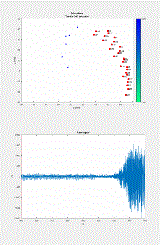Phase Shift Over Subdural Leads Permits Real Time Localization of the Seizure Source During the Interictal-Ictal Transition
Abstract number :
3.165
Submission category :
3. Neurophysiology / 3G. Computational Analysis & Modeling of EEG
Year :
2018
Submission ID :
502731
Source :
www.aesnet.org
Presentation date :
12/3/2018 1:55:12 PM
Published date :
Nov 5, 2018, 18:00 PM
Authors :
Joshua Diamond, University of Virginia; Sara Inati, National Institute of Neurological Disorders and Stroke, NIH; and Kareem Zaghloul, National Institute of Neurological Disorders and Stroke, NIH
Rationale: Seizure source localization remains a critical problem in the evaluation of intracranial EEG (iEEG) for the treatment of medication-refractory epilepsy. Post-surgical seizure control is currently sub-optimal, demonstrating the need for improved methods of seizure source detection. Current methodology relies on identification of electrodes which are the first to participate in seizure onset. These electrodes are believed to overly the seizure onset zone, and the tissue underlying them is resected. However, this method fails to appreciate the fact that seizure activity at a surface lead may have propagated from a deep source. Electric source imaging may capture three-dimensional seizure source information. However, this methodology has not been studied in, and may be inappropriate for, ictal iEEG data. This is particularly true during the transition between interictal and ictal states, during which recorded voltage is low and therefore electric dipoles may not be reliably detected. We therefore have developed a method of seizure source detection which is agnostic to voltage amplitude. Rather, this method considers differences in the phase of the time series data across electrodes. This method appears to successfully localize the seizure source during the interictal-ictal transition. Methods: After bandpass-filtering the raw signal at 5-15 Hz, we extracted phase information from each iEEG trace using the Hilbert transform. Using fundamental relationships in wave propagation, phase shifts in iEEG signal from one electrode to another were used to establish differences in the relative distance between each electrode and the hypothesized source of seizure activity. We aggregated these differences over many electrode pairs, and solved for the single most likely source point. We thus identified source location at each time point before and during the seizure. Results: Our method reliably chose seizure sources near, though often deep to, contacts that were identified as ictally-active by a clinical epileptologist. To verify that identified sources were statistically reliable, we shuffled the phase distributions across electrode leads and found that source localization was nearly absent in shuffled data. In most cases, the chosen source was confined a relatively well-defined region of space. Interestingly, in the time domain, we found that source selection occurred most reliably during the interictal-ictal transition, but was less avid during seizure itself. This comes in contrast to electric source imaging, which most reliably detected the seizure source in the pre-termination phase. Conclusions: Source localization using phase shifts captured in the iEEG signals may be a promising new tool in pre-surgical planning for medication-refractory epilepsy. Funding: This work was supported by the intramural research program of the National Institute for Neurological Disorders and Stroke. This research was also made possible through the NIH Medical Research Scholars Program, a public-private partnership supported jointly by the NIH and generous contributions to the Foundation for the NIH from the Doris Duke Charitable Foundation, the American Association for Dental Research, the Colgate-Palmolive Company, Genentech, Elsevier, and other private donors.
